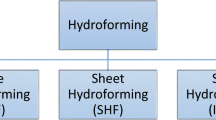Abstract
Many problems like precision control difficulty, unstable structure properties, and waste of welding materials were encountered when remanufacturing hot forging die with manual arc surfacing method. Therefore, the automatic wire arc additive remanufacturing (WAAM) technology is put forward. By using failed forging die as remanufacturing substrate, this technology can bring out double advantages of cyclic utilization and high accuracy, which is of great application prospect. In this paper, the WAAM process of a failed crankshaft forging die is studied. Firstly, a new slicing algorithm which gets its outline polygon by classifying and reconstructing the intersection points of triangular patches and tangent planes is proposed. The key thought of this algorithm is to judge the order of these intersection points with normal vector and put them into the “starting” or “ending” arrays. By traversing through these two arrays, the treatment efficiency gets much better than before. Simultaneously, by parameterizing the chord length accumulation, an interpolation fitting algorithm is introduced to improve the accuracy of outline polygon and the criterion equation of outline polygon’s orientation is deduced. Then a composite filling algorithm with uniform inside and smooth margin is developed to meet the requirements of WAAM process. Finally, the WAAM process for a failed crankshaft forging die is conducted, which justifies the feasibility of the whole process.

















Similar content being viewed by others
References
Falk B, Engle U (1998) Estimation of tool life in bulk metal forming based on different failure concepts. J Mater Process Technol 80:602–607
Wang HC, Yang C, Wang HJ (2008) Temperature field of the hot forging die under the continuous working state. J Wuhan Univ Technol 30(6):37–40
Zhang JS, Zhou J, Tao YP (2015) The microstructure and properties change of dies manufactured by bimetal-gradient-layer surfacing technology. Int J Adv Manuf Technol 80:1804–1807
Shen L, Zhou J, Ma X, Zhang JS (2017) Microstructure and mechanical properties of hot forging die manufactured by bimetal-layer surfacing technology. J Mater Process Technol 239:147–159
Ma C (2009) Research on microstructure and property of flux-cored welding wire surfacing. Dissertation, Wuhan University of Technology
Zhao K, Wang HY (2002) Obtaining composite deposits consisting of Fe-base alloy + WC cemented carbide particles under PTA. Trans China Weld Instit 23:56–58
Lu S, Zhou J, Zhang JS (2015) Optimization of welding thickness on casting-steel surface for production of forging die. Int J Adv Manuf Technol 76:1411–1419
J.S Zhang (2019) Process planning and experimental research on automatic wire arc additive remanufacturing for hot forging die. Dissertation, Chongqing University
Morrow WR, Qi H, Kim I (2007) Environmental aspects of laser-based and conventional tool and die manufacturing. J Clean Prod 15:932–943
Huang RZ, Riddle M (2016) Energy and emissions saving potential of additive manufacturing: the case of lightweight aircraft components. J Clean Prod 135:1559–1570
Waston JK, Taminger KM (2018) A decision-support model for selecting additive manufacturing versus subtractive manufacturing based on energy consumption. J Clean Prod 176:1316–1322
Ding DH, Pan ZX, Cuiuri D (2015) Wire-feed additive manufacturing of metal components: technologies, developments and future interests. Int J Adv Manuf Technol 81:465–481
Xiong J, Zhang G, Qiu Z (2013) Vision-sensing and bead width control of a single-bead multi-layer part: material and energy savings in GMAW-based rapid manufacturing. J Clean Prod 41:82–88
Li ZY, Xie CX, Yang JH (2002) Rapid acquirement of STL files’ topologic information and timely layer process. Comput Eng Appl 7:32–35
Hou CC, Nan L, Zhang L (2014) Algorithm for rapid slicing in STL model based on grouping array. Manuf Autom 9:12–15
P. Almeida, S. William(2010) Innovative process model of Ti-6Al-4V additive layer manufacturing using cold metal transfer (CMT). The Twenty-first Annual International Solid Freeform Fabrication Symposium, Austin: University of Texas
Ding YY, Dwivedi R, Kovacevic R (2017) Process planning for 8-axis robotized laser-based direct metal deposition system: a case on building revolved part. Robot Cim-Int Manuf 44:67–76
Wang XL, Wang AM (2019) A sequential path-planning methodology for wire and arc additive manufacturing based on a water-pouring rule. Int J Adv Manuf Technol 103:3813–3830
Xiong J, Lei Y, Chen H (2017) Fabrication of inclined thin-walled parts in multi-layer single-pass GMAW-based additive manufacturing with flat position deposition. J Mater Process Technol 240:397–403
Ogino Y, Asai S, Hirata YY (2018) Numerical simulation of WAAM process by a GMAW weld pool model. Weld World 62:393–401
Xu XF, Ganguly S (2019) Preliminary investigation of building strategies of maraging steel bulk material using wire arc additive manufacture. J Mater Eng Perform 28:594–600
Martina F, Mehnen J, Williams SW (2012) Investigation of the benefits of plasma deposition for the additive layer manufacturing of Ti-6Al-4V. J Mater Process Technol 212:1377–1386
Funding
This research is financially supported by the National Key Research and Development Program of China (No. 2018YFB1106504)and Chongqing Technological Innovation and Application Demonstration Program (No. cstc2018jszx-cyzdX0121).
Author information
Authors and Affiliations
Corresponding author
Additional information
Publisher’s note
Springer Nature remains neutral with regard to jurisdictional claims in published maps and institutional affiliations.
Rights and permissions
About this article
Cite this article
Zhang, J., Zhou, J., Wang, Q. et al. Process planning of automatic wire arc additive remanufacturing for hot forging die. Int J Adv Manuf Technol 109, 1613–1623 (2020). https://doi.org/10.1007/s00170-020-05766-0
Received:
Accepted:
Published:
Issue Date:
DOI: https://doi.org/10.1007/s00170-020-05766-0




